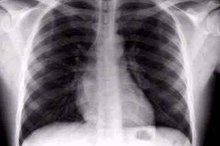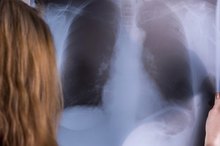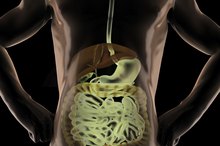Causes of Spots on Lungs
Occasionally a chest x-ray or computed tomography (CT) scan will reveal an unexpected abnormality in one or both lungs. Doctors may use terms like spot, lesion, mass or nodule to describe these abnormalities. While cancer is a possibility that everyone fears, most lung spots have other causes, such as infections, noncancerous growths or even blood vessel abnormalities.
If you are experiencing serious medical symptoms, seek emergency treatment immediately.
Infections and Granulomas
Infections are one of the most common causes of spots on the lungs. Some spots are caused by current infections, such as pneumonia, while others are due to abnormalities remaining after previous infections. Granulomas are small areas of inflammation that can occur almost anywhere in the body but are frequently found in the lungs. They are usually caused by a past infection but may also be seen with a current infection or even some noninfectious conditions. Tuberculosis and certain fungal infections are frequent causes of lung granulomas. One of the most common noninfectious reasons for lung granulomas is sarcoidosis, a disease of unknown cause that can produce granulomas in multiple organs.
- Infections are one of the most common causes of spots on the lungs.
- One of the most common noninfectious reasons for lung granulomas is sarcoidosis, a disease of unknown cause that can produce granulomas in multiple organs.
Noncancerous Growths
What Does a Smoker's X-Ray Look Like?
Learn More
A variety of noncancerous growths may cause spots on the lungs. They often produce no or minimal symptoms and are detected unexpectedly on x-rays and other imaging studies done for unrelated reasons. Hamartomas, lipomas and fibromas account for most noncancerous lung growths. Hamartomas are disorganized collections of cells that can be found in many different parts of the body, including the lungs. Lung hamartomas are often made of cartilage cells. Lipomas are localized collections of fat cells that grow inside a capsule. Fibromas are accumulations of fibrous tissue, a type of tissue containing fibers made of proteins, such as collagen.
- A variety of noncancerous growths may cause spots on the lungs.
- Hamartomas are disorganized collections of cells that can be found in many different parts of the body, including the lungs.
Cancerous Growths
Cancer is the most serious and potentially life-threatening cause of spots on the lungs 1. The cancer may begin in a lung or it may spread to one or both lungs from another location in the body. Treatment and survival after being diagnosed with lung cancer vary greatly. A single, small cancer that originated in a lung and has not yet spread elsewhere may be very treatable. Multiple, large growths in both lungs arising from cancer that spread from another body region are more difficult to treat.
- Cancer is the most serious and potentially life-threatening cause of spots on the lungs 1.
- Multiple, large growths in both lungs arising from cancer that spread from another body region are more difficult to treat.
Pancreatic Cancer & Fluid Buildup in the Lungs
Learn More
A variety of other conditions may also cause spots on the lungs, including blood vessel abnormalities or autoimmune diseases like rheumatoid arthritis. Some are harmless while others are very serious.
Radiologists frequently comment on the appearance of lung spots to help your doctor make decisions about the need for further investigations. At times, the radiologist will indicate that a spot looks like it is due to an insignificant condition that requires no further testing, such as scar tissue from a previous infection. In other instances, the radiologist may recommend additional investigations to determine the exact cause, such as blood tests, other imaging tests or a biopsy. Your doctor will also use other factors to determine whether you need further testing, such as whether you have symptoms, are a past or current smoker or have been exposed to certain infectious diseases or toxic substances. Past or current medical conditions, such as cancer or autoimmune diseases, will also be considered.
Reviewed by Mary D. Daley, MD.
- A variety of other conditions may also cause spots on the lungs, including blood vessel abnormalities or autoimmune diseases like rheumatoid arthritis.
- Your doctor will also use other factors to determine whether you need further testing, such as whether you have symptoms, are a past or current smoker or have been exposed to certain infectious diseases or toxic substances.
Related Articles
References
- The New England Journal of Medicine: Probability of Cancer in Pulmonary Nodules Detected on First Screening CT
- Chest: Evaluation of Individuals With Pulmonary Nodules: When Is It lung Cancer? Diagnosis and Management of Lung cancer, 3rd ed: American College of Chest Physicians Evidence-based Clinical Practice Guidelines.
- American Family Physician: Evaluation of the Solitary Pulmonary Nodule
- Merk Manual Professional Version: Sarcoidosis
- Merck Manual Consumer Version: Overview of Lung Tumors
- Merck Manual Professional Version: Overview of Lung Tumors
- Merck Manual Professional Version: Lung Carcinoma
- Oshimo S, Guzman J, Costabel U, Bonella F. Differential diagnosis of granulomatous lung disease: clues and pitfalls: Number 4 in the Series "Pathology for the clinician" Edited by Peter Dorfmüller and Alberto Cavazza. European Respiratory Review. 2017. 26(145). pii: 170012. doi:10.1183/16000617.0012-2017
- Shah J, Shahidullah A. Ascaris lumbricoides: A Startling Discovery during Screening Colonoscopy. Case Rep Gastroenterol. 2018;12(2):224–229. Published 2018 May 31. doi:10.1159/000489486
- Parejo-Moron AI, Tornero-Divieso ML, Fernandez-Diaz MR, et al. Necrotizing sarcoid granulomatosis: A disease not to be forgotten. Case Reports in Medicine. 2020. 2020:5730704. doi:10.1155/2020/5730704
- Eliadou E, Moleiro J, Ribaldone DG, et al. Interstitial and granulomatous lung disease in inflammatory bowel disease patients. Journal of Crohns and Colitis. 2019. doi:10.1093/ecco-jcc/jjz165
- Yasmin H, Mangano WE, Malhotra P, Farooq A, Mohamed H. Hot tub lung: A diagnostic challenge. Cureus. 2017. 9(8):e1617. doi:10.7759/cureus.1617
- Tomioka H, Kaneda T, Katsuyama E, et al. Elemental analysis of occupational granulomatous lung disease by electron probe microanalyzer with wavelength dispersive spectrometer: Two case reports. Respiratory Medicine Case Reports. 2016. 18:66-72. doi:10.1016/j.rmcr.2016.04.009
- Ronsmans S, Verbeken EK, Adams E, et al. Granulomatous lung disease in two workers making light bulbs. American Journal of Industrial Medicine. 2019. 62(10):908-913. doi:10.1002/ajim.23030
- Jasuja S, Kuhn BT, Schivo M, Adams JY. Cosmetic talc-related pulmonary granulomatosis. Journal of Investigational Medicine and High Impact Case Reports. 2017. 5(3):2324709617728527. doi:10.1177/2324709617728527
- Kreider M, Highland K. Pulmonary involvement in Sjögren syndrome. Seminars in Respiratory and Critical Care Medicine. 2014. 35(2):255-64. doi:10.1055/s-0034-1371529
- National Organization for Rare Disorders. Granulomatosis with polyangiitis. Updated 2017.
- Rao N, Mackinnon AC, Routes JM. Granulomatous and lymphocytic interstitial lung disease: a spectrum of pulmonary histopathologic lesions in common variable immunodeficiency--histologic and immunohistochemical analyses of 16 cases. Hum Pathol. 2015;46(9):1306–1314. doi:10.1016/j.humpath.2015.05.011
- Suri HS, Yi ES, Nowakowski GS, Vassallo R. Pulmonary langerhans cell histiocytosis. Orphanet J Rare Dis. 2012;7:16. doi:10.1186/1750-1172-7-16
- Lu T, Zhan C, Huang T, et al. Small pulmonary granuloma is often misdiagnosed as lung cancer by positron emission tomography/computer tomography in diabetic patients. Interactive Cardiovascular and Thoracic Surgery. 2019. 28(3):394-398. doi:10.1093/icvts/ivy263
- Adams TN, Newton CA, Batra K, et al. Utility of bronchoalveolar lavage and transbronchial biopsy in patients with hypersensitivity pneumonitis. Lung. 2018;196(5):617–622. doi:10.1007/s00408-018-0139-1
- Culver DA, Judson MA. New advances in the management of pulmonary sarcoidosis. BMJ. 2019. 367:l5553. doi:10.1136/bmj.l5553
- Shih JA, Crotty RK, Nagarur A. Granulomatous and lymphocytic interstitial lung disease. Postgraduate Medicine. 2019. 95(1125):394-395. doi:10.1136/postgradmedj-2019-136541
- Williams A, Kelleher WP, Nicholson AG, et al. Diffuse granulomatous disease: Looking inside and outside the lungs. Thorax. 2020. 75(2):189-191. doi:10.1136/thoraxjnl-2019-213797
Writer Bio
Dr. Ann M. Hester is a board-certified internal medicine specialist and author. She is also the creator of the Patient Whiz patient engagement app for iOS and Total en Salud health app in Spanish.








